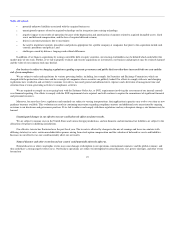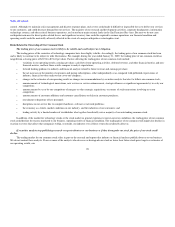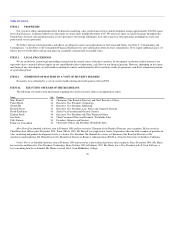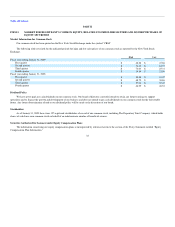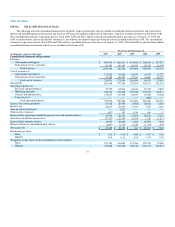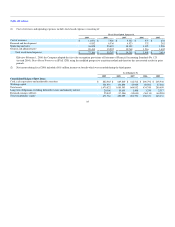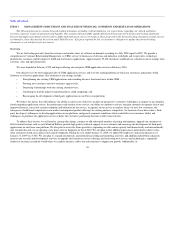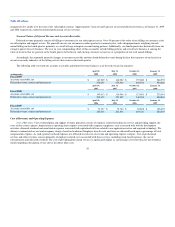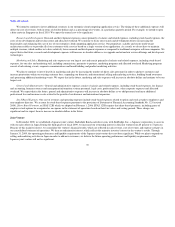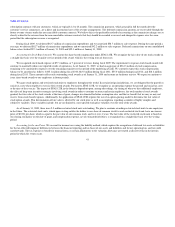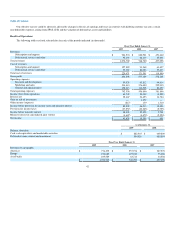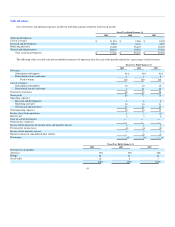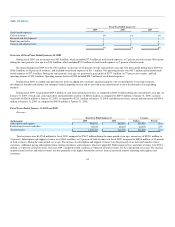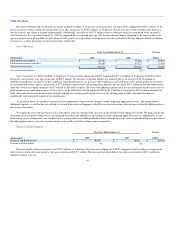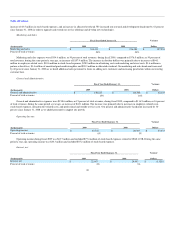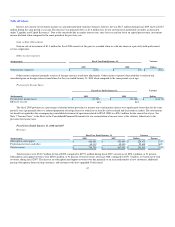Salesforce.com 2008 Annual Report Download - page 40
Download and view the complete annual report
Please find page 40 of the 2008 Salesforce.com annual report below. You can navigate through the pages in the report by either clicking on the pages listed below, or by using the keyword search tool below to find specific information within the annual report.
Table of Contents
our effort to further strengthen and extend our service offering, we may acquire or make investments in complementary companies, services and technologies.
In August 2008, we acquired InStranet, Inc. which offers a knowledge management application for business to consumer call centers. We acquired
InStranet, Inc. for its developed technology in order to expand our CRM customer service and support offerings in the customer service and support market.
Additionally during the third quarter of fiscal 2009, we increased our ownership in our Japanese joint venture from 65 percent to 72 percent.
We expect marketing and sales costs, which were 50 percent of our total revenues for fiscal 2009 and the same for the period a year ago, to continue to
represent a substantial portion of total revenues in the future as we seek to add and manage more paying subscribers, and build brand awareness.
Fiscal Year
Our fiscal year ends on January 31. References to fiscal 2009, for example, refer to the fiscal year ended January 31, 2009.
Sources of Revenues
We derive our revenues from two sources: (1) subscription revenues, which are comprised of subscription fees from customers accessing our enterprise
cloud computing application service, and from customers purchasing additional support beyond the standard support that is included in the basic subscription
fee; and (2) related professional services and other revenues consisting primarily of training fees. Subscription and support revenues accounted for
approximately 91 percent of our total revenues during fiscal 2009. Subscription revenues are driven primarily by the number of paying subscribers of our
service and the subscription price of our service. None of our customers accounted for more than 5 percent of our revenues during fiscal 2009, 2008 and 2007.
Subscription and support revenues are recognized ratably over the contract terms beginning on the commencement dates of each contract. The typical
subscription and support term is 12 to 24 months, although terms range from one to 60 months. Our subscription and support contracts are noncancelable,
though customers typically have the right to terminate their contracts for cause if we materially fail to perform. We generally invoice our customers in
advance, in annual or quarterly installments, and typical payment terms provide that our customers pay us within 30 days of invoice. Amounts that have been
invoiced are recorded in accounts receivable and in deferred revenue, or in revenue depending on whether the revenue recognition criteria have been met. In
general, we collect our billings in advance of the subscription service period.
Professional services and other revenues consist of fees associated with consulting and implementation services and training. Our consulting and
implementation engagements are typically billed on a time and materials basis. We also offer a number of classes on implementing, using and administering
our service that are billed on a per person, per class basis. Our typical payment terms provide that our customers pay us within 30 days of invoice.
We recognize revenue in accordance with the provisions of SEC Staff Accounting Bulletin No. 104, "Revenue Recognition," or SAB 104, and
Emerging Issues Task Force, or EITF, Issue No. 00-21, "Revenue Arrangements with Multiple Deliverables," or EITF 00-21. In determining whether
professional services can be accounted for separately from subscription and support revenues, we consider a number of factors, which are described in
"Critical Accounting Policies and Estimates—Revenue Recognition" below. As we introduce new service offerings, we may not be able to establish objective
and reliable evidence of fair value for these elements of our sales arrangements. As a result, when the professional services are sold together with subscription
services that do not have objective and reliable evidence of fair value, the professional services fees cannot be accounted for separately, and the entire
arrangement is accounted for as a single unit of accounting. In such situations, we recognize the entire
37


